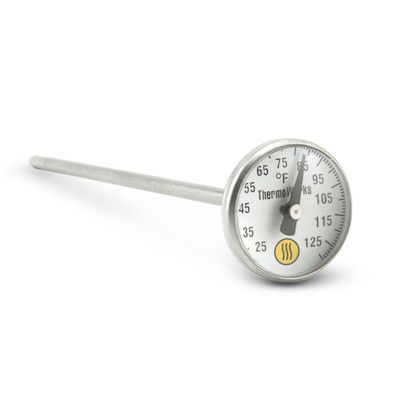Here are answers to common thermometry questions we receive about using a thermometer to determine the doneness of food, calibration, accuracy, and water-resistance.
How do I know when my food is done cooking?
It may seem like an obvious point, but a thermometer is just a tool that gives you information about the temperature of the food you are preparing. You have to make the decisions about when to increase or decrease the heat and about when things are done based on the information the thermometer gives. In most cases, look for the lowest temperature reached in the thickest part of the food to judge doneness.
While different people like their meat or other food prepared to different levels of doneness, here is a chart of chef-recommended temperatures to get you started.
Where should I place my probe tip to gauge doneness?
When testing doneness in most cooked foods, the coldest part will be the very center of the thickest portion. With larger foods, you can take quick readings with your thermometer in several locations to verify that the entire portion is done. If you are chilling a food, the center of the thickest part will be the last to cool.
Keep in mind that different types of thermometers have sensors of different sizes.
A dial thermometer can have a sensor as big as an inch long and your reading will be an average of the temperature of all the different materials touching that sensor.
 ƒmi
ƒmi
Most digital thermometers have small sensors at their tip. Penetrate the food you are checking with the probe and place the very tip of the probe where you want to measure.
How often should I calibrate my thermometer?
The word “calibrate” is often misunderstood to mean necessarily making some kind of adjustment to a thermometer for accuracy. While adjustments are sometimes needed, “calibrating” a thermometer simply means testing its accuracy against a verifiable standard. If the thermometer is within the accuracy specification listed by the manufacturer or quality control agency, no adjustment should be made.
When it comes to recommended frequency, there is a very wide range. Mechanical thermometers (like dial thermometers) should be calibrated very regularly, if not daily, while digital thermometers are often only calibrated once a year. Check the manufacturer’s recommendation for your particular type and model of thermometer or check with the appropriate health department or quality control agency with authority over your operation.
How do I calibrate my thermometer?
Again, the answer depends upon the requirements of the presiding health department or quality control agency. Many organizations, including corporations, require lab calibration of thermometers for professional use. ThermoWorks’ Calibration Laboratory is accredited by A2LA (American Association for Laboratory Accreditation) and is thereby independently certified to perform calibrations within the boundaries of a specific scope of capabilities. Contact us at calibration@thermoworks.com or ask for the Calibration Lab at 1-800-393-6434.
While it is true that the most definitive test of a thermometer’s calibration follows at least a 3-point method, the use of a properly made ice bath is a widely used test in the food industries and is recommended by the USDA and other agencies.
The most common error in an electronic temperature sensor is a shift in the base electrical value which can be seen in an ice bath test. If a digital thermometer has been once calibrated successfully at other temperatures, and it can be shown to read accurately in an ice bath thereafter, then the likelihood that it reads correctly at other temperatures is greater.
Why does my ThermoWorks thermometer show a reading higher than 32°F (0°C) when I put it in ice water?
Probably, because the temperature is higher than the ice point unless you take the time to create a properly made ice bath. If the thermometer is, in fact, outside of its published accuracy specification, adjust accordingly or contact our Tech Support team for help by emailing techsupport@thermoworks.com or by calling 1-800-393-6434.
I’m having trouble turning my thermometer on. Why?
Check the battery compartment. In many thermometers, there is a small metal clip that holds the batteries in place. Even if the batteries are in place, if they are not under this little clip, the thermometer won’t turn on. If the clip is in place and the thermometer still won’t turn on, contact our famous Tech Support team for help by emailing techsupport@thermoworks.com or by calling 1-800-393-6434.
Why does my new ThermoWorks thermometer read 3-5 degrees different than my old thermometer?
Most likely, because your old thermometer is not as accurate as your new ThermoWorks digital thermometer. Test both thermometers in a properly made ice bath to check and adjust accordingly or contact our Tech Support team for help by emailing techsupport@thermoworks.com or by calling 1-800-393-6434.
Why doesn’t my ThermoWorks thermometer seem to settle on a final temperature in food?
Typically, because the temperature of food keeps changing while it is cooking, and your ThermoWorks digital thermometer is accurate enough to read these changes. Thermometers don’t “lock in” on a given reading unless they have a “hold” feature designed to do that.
Am I supposed to clean my ThermoWorks thermometer? How and how often?
You should wipe the probe clean with cleansing wipes or soap any time it comes in contact with raw meat, and you should wipe the whole thermometer casing after each use, being careful not to get it wet. Never put the housing of your digital thermometer near water unless it has an IP rating of 66 or higher.
What is an IP rating?
One common added feature for electronic thermometers, particularly electronic cooking thermometers, is a splash-proof or waterproof rating.
The International Electrotechnical Commission (IEC) has created a standard for rating instruments based on their ability to protect their electronic components from corrosion by water or dust. The International Protection Rating code (or IP code) consists of the letters “IP” followed by two numbers.
The first number tells you how protected an instrument’s electronics are from penetration by solids (like dust) and the second number tells you how they stand up against liquids according to the following table:
| First number Protection against solid objects |
Second Number Protection against liquids |
||
| 0 | No protection | 0 | No protection |
| 1 | Protected against solids objects over 50mm (e.g. accidental touch by hands) | 1 | Protected against vertically falling drops of water |
| 2 | Protected against solids objects over 12mm (e.g. fingers) | 2 | Protected against direct sprays up to 15° from the vertical |
| 3 | Protected against solids objects over 2.5mm (e.g. tools and wires) | 3 | Protected against direct sprays up to 60° from the vertical |
| 4 | Protected against solids objects over 1mm (e.g. tools, wires and small wires) | 4 | Protected against sprays from all directions – limited ingress permitted |
| 5 | Protected against dust – limited ingress (no harmful deposit) | 5 | Protected against low pressure jets of water from all directions – limited ingress permitted |
| 6 | Totally protected against dust | 6 | Protected against strong jets of water e.g. for use on shipdecks – limited ingress permitted |
| 7 | Protected against the effects of temporary immersion between 15cm and 1m. Duration of test 30 minutes | ||
| 8 | Protected against long periods of immersion under pressure |
If, for example, a thermometer has a rating of “IP65,” that would mean that it was tested and found completely protected against dust as well as protected against low pressure jets of liquid from all sides, but not protected against immersion, or an accidental drop into the soup.
Have more questions?
Contact our Tech Support team. They’ll be happy to assist you.
Email: techsupport@thermoworks.com
Phone: Toll Free: 800-393-6434 6am – 8pm M-F, 9am – 4pm Saturday, MT
LiveChat: 8am – 5pm M-F



















